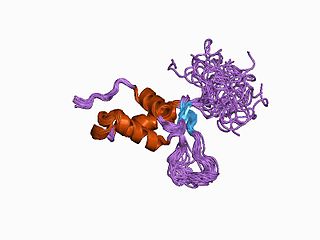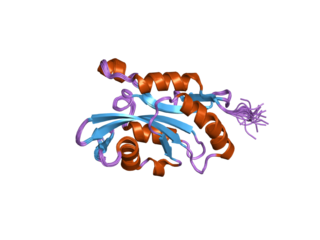Related Research Articles

The GABA receptors are a class of receptors that respond to the neurotransmitter gamma-aminobutyric acid (GABA), the chief inhibitory compound in the mature vertebrate central nervous system. There are two classes of GABA receptors: GABAA and GABAB. GABAA receptors are ligand-gated ion channels ; whereas GABAB receptors are G protein-coupled receptors, also called metabotropic receptors.
Ectopic is a word used with a prefix, ecto, meaning “out of place.” Ectopic expression is an abnormal gene expression in a cell type, tissue type, or developmental stage in which the gene is not usually expressed. The term ectopic expression is predominantly used in studies using metazoans, especially in Drosophila melanogaster for research purposes.

Paired box protein Pax-6, also known as aniridia type II protein (AN2) or oculorhombin, is a protein that in humans is encoded by the PAX6 gene.

Forkhead box protein C2 (FOXC2) also known as forkhead-related protein FKHL14 (FKHL14), transcription factor FKH-14, or mesenchyme fork head protein 1 (MFH1) is a protein that in humans is encoded by the FOXC2 gene. FOXC2 is a member of the fork head box (FOX) family of transcription factors.
Myc is a family of regulator genes and proto-oncogenes that code for transcription factors. The Myc family consists of three related human genes: c-myc (MYC), l-myc (MYCL), and n-myc (MYCN). c-myc was the first gene to be discovered in this family, due to homology with the viral gene v-myc.

N-myc proto-oncogene protein also known as N-Myc or basic helix-loop-helix protein 37 (bHLHe37), is a protein that in humans is encoded by the MYCN gene.

Pre-lamin A/C or lamin A/C is a protein that in humans is encoded by the LMNA gene. Lamin A/C belongs to the lamin family of proteins.

The SKI protein is a nuclear proto-oncogene that is associated with tumors at high cellular concentrations. SKI has been shown to interfere with normal cellular functioning by both directly impeding expression of certain genes inside the nucleus of the cell as well as disrupting signaling proteins that activate genes.
The Let-7 microRNA precursor was identified from a study of developmental timing in C. elegans, and was later shown to be part of a much larger class of non-coding RNAs termed microRNAs. miR-98 microRNA precursor from human is a let-7 family member. Let-7 miRNAs have now been predicted or experimentally confirmed in a wide range of species (MIPF0000002). miRNAs are initially transcribed in long transcripts called primary miRNAs (pri-miRNAs), which are processed in the nucleus by Drosha and Pasha to hairpin structures of about 70 nucleotide. These precursors (pre-miRNAs) are exported to the cytoplasm by exportin5, where they are subsequently processed by the enzyme Dicer to a ~22 nucleotide mature miRNA. The involvement of Dicer in miRNA processing demonstrates a relationship with the phenomenon of RNA interference.

Beclin-1 is a protein that in humans is encoded by the BECN1 gene. Beclin-1 is a mammalian ortholog of the yeast autophagy-related gene 6 (Atg6) and BEC-1 in the C. elegans nematode. This protein interacts with either BCL-2 or PI3k class III, playing a critical role in the regulation of both autophagy and cell death.

Homeobox protein SIX1 is a protein that in humans is encoded by the SIX1 gene.

Fibroblast growth factor 4 is a protein that in humans is encoded by the FGF4 gene.

Dachshund homolog 1, also known as DACH1, is a protein which in humans is encoded by the DACH1 gene. DACH1 has been shown to interact with Ubc9, Smad4, and NCoR.
Mouse models of colorectal cancer and intestinal cancer are experimental systems in which mice are genetically manipulated, fed a modified diet, or challenged with chemicals to develop malignancies in the gastrointestinal tract. These models enable researchers to study the onset, progression of the disease, and understand in depth the molecular events that contribute to the development and spread of colorectal cancer. They also provide a valuable biological system, to simulate human physiological conditions, suitable for testing therapeutics.

Apposition eyes are the most common form of eye, and are presumably the ancestral form of compound eye. They are found in all arthropod groups, although they may have evolved more than once within this phylum. Some annelids and bivalves also have apposition eyes. They are also possessed by Limulus, the horseshoe crab, and there are suggestions that other chelicerates developed their simple eyes by reduction from a compound starting point. Some caterpillars appear to have evolved compound eyes from simple eyes in the opposite fashion.

Cofilin 2 (muscle) also known as CFL2 is a protein which in humans is encoded by the CFL2 gene.

The Hippo signaling pathway, also known as the Salvador-Warts-Hippo (SWH) pathway, is a signaling pathway that controls organ size in animals through the regulation of cell proliferation and apoptosis. The pathway takes its name from one of its key signaling components—the protein kinase Hippo (Hpo). Mutations in this gene lead to tissue overgrowth, or a "hippopotamus"-like phenotype.

Dachshund homolog 2 is a protein that in humans is encoded by the DACH2 gene.

Ski/Dach domain-containing protein 1 is a protein that in humans is encoded by the SKIDA1 gene. It is also known as C10orf140 and DLN-1. It has orthologs in vertebrates. It has two domains: the Ski/Sno/Dac domain and a domain of unknown function, DUF4854. It is associated with multiple types of cancer, like leukemia, ovarian cancer, and colon cancer. It's predicted to be a nuclear protein. It may interact with PRC2.
Barry James Thompson is an Australian and British developmental biologist and cancer biologist. He is a professor of the John Curtin School of Medical Research at the Australian National University in Canberra. Thompson is known for identifying genes, proteins and mechanisms involved in epithelial polarity, morphogenesis and cell signaling via the Wnt and Hippo signaling pathways, which have key roles in human cancer.
References
- ↑ Mardon G, Solomon NM, Rubin GM (December 1994). "dachshund encodes a nuclear protein required for normal eye and leg development in Drosophila". Development. 120 (12): 3473–86. doi:10.1242/dev.120.12.3473. PMID 7821215.
- ↑ Gehring WJ, Ikeo K (September 1999). "Pax 6: mastering eye morphogenesis and eye evolution". Trends in Genetics. 15 (9): 371–7. doi:10.1016/S0168-9525(99)01776-X. PMID 10461206.
- ↑ Estella C, Voutev R, Mann RS (2012-01-01). "A dynamic network of morphogens and transcription factors patterns the fly leg". Current Topics in Developmental Biology. 98: 173–98. doi:10.1016/B978-0-12-386499-4.00007-0. ISBN 9780123864994. PMC 3918458 . PMID 22305163.
- ↑ Popov VM, Wu K, Zhou J, Powell MJ, Mardon G, Wang C, Pestell RG (January 2010). "The Dachshund gene in development and hormone-responsive tumorigenesis". Trends in Endocrinology and Metabolism. 21 (1): 41–9. doi:10.1016/j.tem.2009.08.002. PMC 2818438 . PMID 19896866.